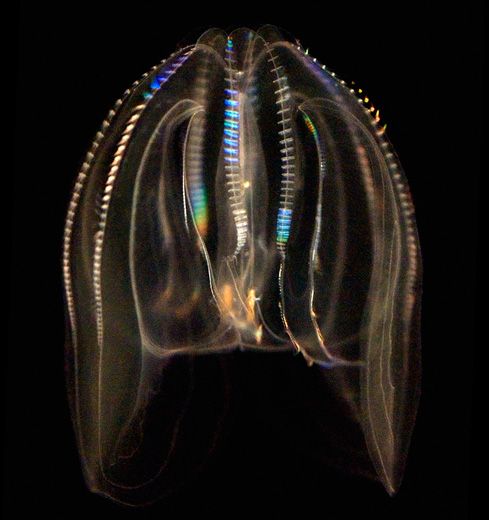How Can a Jellyfish This Slow Be So Deadly? It’s Invisible
One of the world’s most devastating predators is brainless, slow and voracious
/https://tf-cmsv2-smithsonianmag-media.s3.amazonaws.com/filer/Phenom-Mnemiopsis-631.jpg)
One of the planet’s most notorious invasive species is a comb jelly, Mnemiopsis leidyi. A native of the east coast of North and South America, the comb jelly is capable of eating ten times its body weight per day, starving entire ecosystems by scarfing up everything at the bottom of the food chain. For decades, marine biologists have been baffled by the creature’s hunting prowess, since it is slow, blind and brainless (it’s also known as the “sea walnut”). But scientists finally discovered the secret of its success: The jelly is invisible to its prey.
That information could be valuable intel in fending off the latest Mnemiopsis invasion. The comb jelly, which devastated the fishing industry in the anchovy-rich Black Sea in the 1980s, was recently discovered in the Bornholm Basin, seat of the Baltic Sea’s cod population.
Boiled with mustard sauce, cod is a beloved Danish dish. At the prospect of an impending fishery collapse, the normally stoic Danes “went totally nuts,” says ocean biologist Cornelia Jaspers. Transnational scientific coalitions formed to study Mnemiopsis’ reproductive and dining habits. Jaspers was relieved to learn the cod are safe, thanks to low salinity in the water, which reduces the jelly’s breeding rate. But Mnemiopsis could still wreak havoc, she says, if it expands into saltier seas.
One of the comb jelly’s favorite meals is the copepod— a tiny crustacean that is a vital link in the ocean food chain. Among the swiftest animals in nature, the copepod is able to travel 800 body lengths in a second. Copepods are also incredibly alert, aware of the slightest disturbance in the water around them. But despite being up to 100 times bigger, the sluggish Mnemiopsis is able to sneak up on them.
Research has revealed how. Sean Colin of Rhode Island’s Roger Williams University analyzed the fluid dynamics of Mnemiopsis’ feeding behavior. The jelly eats by beating cilia near its mouth, creating a current that draws seawater, and any resident creatures, into its oral lobes. More cilia carry the tiny animals into the gullet “like luggage on a conveyor belt,” Colin says.
But why doesn’t the copepod flee when its antennae sense the variation in the surrounding water current? Aiming a laser and a camera at a feasting sea walnut, Colin tracked the movement of particles in the feeding current and found that the water stream is so wide and slow that the copepod is oblivious to the jelly’s insidious slurp, which is, in Colin’s words, “hydrodynamically invisible.”
This past summer, Colin began studying whether ocean turbulence disrupts the invisible feeding current. If so, scientists fending off the jelly should be most closely monitoring tranquil areas such as bays and fiords.
To test the hypothesis, Colin is comparing the stomach contents of Mnemiopsis found in choppy and calm waters, catching his specimens by dragging a wide net very slowly. “It’s basically what the jellies do.”
